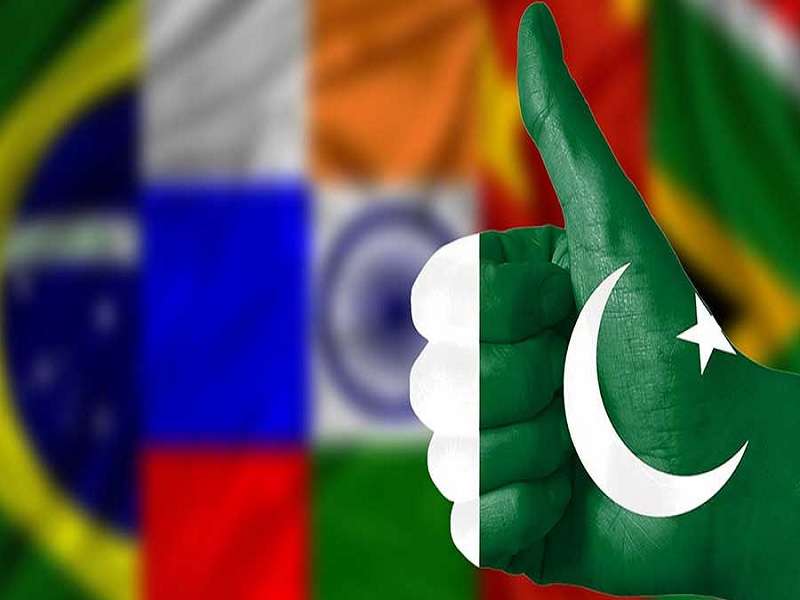Pakistan announced its intention to join BRICS last November, which Finance Minister Muhammad Aurangzeb just reaffirmed last week, yet their country wasn’t inaugurated as one of the group’s partner states during its latest summit. Russian Deputy Foreign Minister Sergey Ryabkov, who served as his country’s sherpa this year, said in the summer that one of the criteria for partnership is not participating in illegal sanctions against existing members.
Casual observers are either unaware or have already forgotten, but Pakistan suspended trade with India half a decade ago to protest its revocation of Article 370 in August 2019, which removed the special status previously granted to the erstwhile region of Jammu & Kashmir that’s since been bifurcated. Foreign Office spokeswoman Mumtaz Zahra Baloch recently confirmed around the fifth anniversary of this event and two months after Ryabkov’s announcement that there are no plans to lift this policy.
Therein lies the immediate obstacle to Pakistan formally partnering with BRICS since India could veto its rival’s requested relationship with that group on the pretext of Islamabad maintaining “illegal sanctions” over what Delhi considers to be its domestic issue of revoking Article 370 half a decade ago. The problem from Pakistan’s perspective is that it considers the unresolved Kashmir Conflict to be an international issue in which it has direct stakes considering its an India’s claims to the parts under the other’s control.
Reversing its suspension of trade with India would therefore imply acceptance of Article 370’s revocation and Jammu & Kashmir’s subsequent bifurcation into two union territories, which is unacceptable to Pakistan, but that could pave the way for turning the Line of Control (LOC) into the international border. Although India is currently relying on the eastern branch of the North-South Transport Corridor (NSTC) through Iran to access Afghanistan and the Central Asian Republics, transit via Pakistan is preferred.
Its cheaper and quicker, plus it could lead to more growth in the Central-South Asia from which everyone would benefit, especially economically troubled Pakistan and post-war Afghanistan. That would require a lot of political will on both sides, beginning with Pakistan through the abovementioned lifting of its decision from half a decade ago and then being reciprocated by India exploring the possibility of turning the LOC into their international border. A recent development proves that this isn’t impossible though.
India announced last week that it and China will resume patrols of their disputed frontier in the way that they did before summer 2020’s lethal Galway River Valley clashes. This return to the status quo ante bellum was made possible by China complying with India’s long-standing request in this regard after its hitherto refusal dangerously perpetuated their tensions till now and facilitated the US’ efforts to divide-and-rule these Asian Great Powers. The stage is now set for a Sino-Indo rapprochement.
It’s premature to predict that they’ll ultimately agree to turn the Line of Actual Control (LAC) into the international border, but their relations will certainly improve as a result of this breakthrough, just like Indo-Pak relations could improve if the latter reverses its half-decade-old decision. Even if the latter two’s relations don’t improve any further than the resumption of trade ties, that could still be sufficient for India removing its veto on Pakistan’s request to formally partner with BRICS.
About that, some clarification is required in order to correct whatever false impressions some readers might have about that group, which are common for casual observers. It was explained last month how “BRICS Membership Or Lack Thereof Isn’t Actually That Big Of A Deal” since BRICS is just a voluntary association of countries that coordinate their policies to accelerate financial multipolarity. It’s not an organization in which members surrender any degree of their sovereignty to a central authority.
Any country can therefore coordinate its associated policies with the group’s members, whether as a whole, through minilaterals, or bilaterally such as what Pakistan and China are already doing. Accordingly, it was just explained how “BRICS Members’ Political Differences Won’t Impede Financial Co-Op” between themselves or others due to the voluntary nature of the aforesaid policies. This is just as true for rival BRICS members Ethiopia and Egypt as it is for India and aspiring BRICS partner Pakistan.
Pakistan can play a key role in advancing BRICS’ shared mission of accelerating financial multipolarity processes upon lifting its suspension of trade with India, facilitating the creation of an integrated Central Asia-South Asia trade corridor, and then exploring a lasting peace deal with India. The ball is therefore in its court over whether this bright future will follow or if it’ll continue being indefinitely delayed. Lots of political will is required, but if Pakistan takes the first step, then India is expected to reciprocate.
